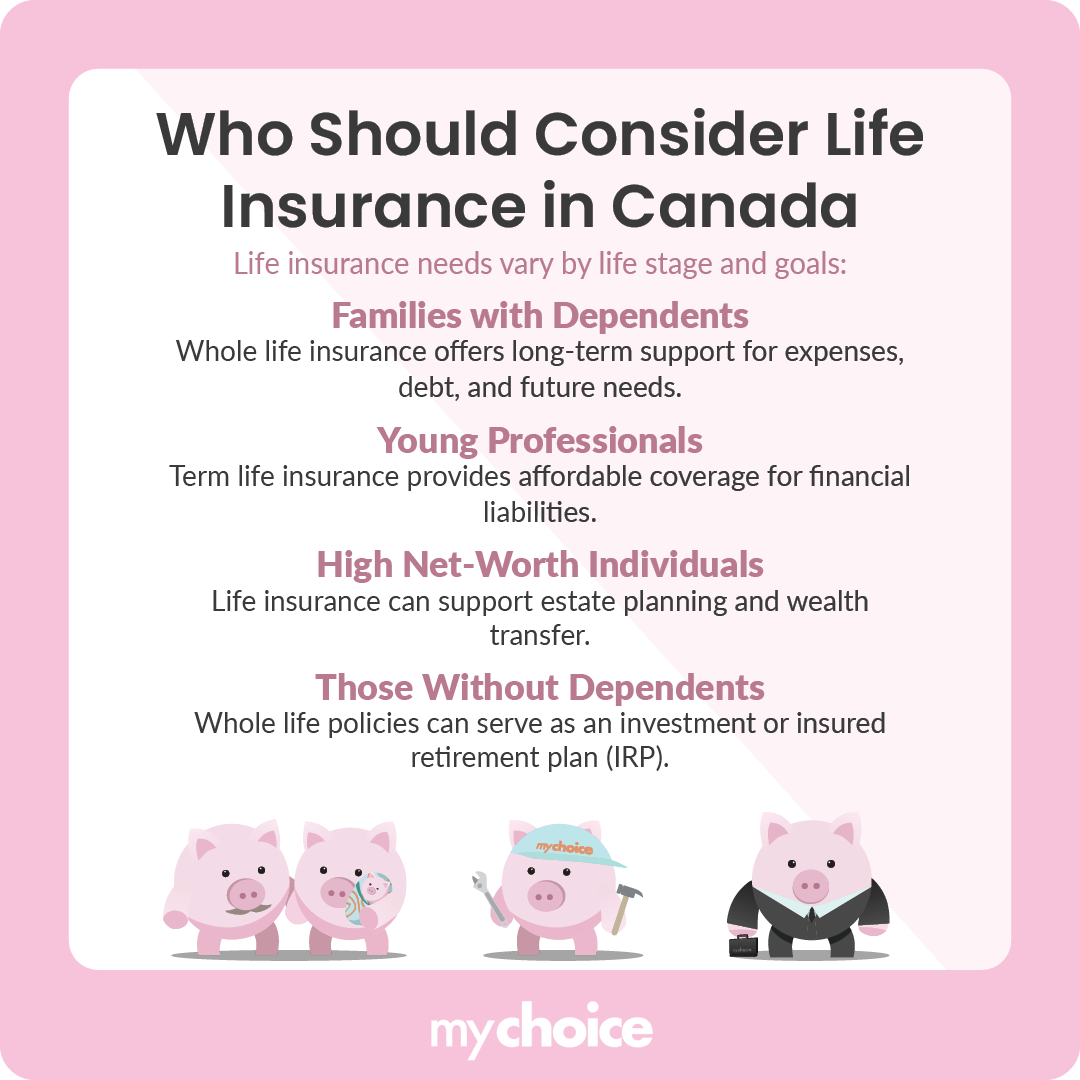Life insurance in Canada is designed to provide financial protection to beneficiaries in the event of the policyholder’s death, but it also offers investment components in specific policies. While term life insurance is geared purely towards protection, whole life and universal life policies combine a death benefit with a cash value component that grows over time. This dual purpose makes life insurance a financial tool that many Canadians consider both a safety net and an investment strategy.
Should you get life insurance? What’s the difference between term life, whole life, and universal life insurance? How does life insurance compare to other forms of investments? Read on to learn how a life insurance policy can help you build wealth and whether it’s worth purchasing a policy.
Life Insurance Value Proposition
The key value proposition of life insurance lies in its ability to combine protection for your loved ones with potential financial growth. For individuals with families, the assurance that their loved ones will have financial support in the event of an untimely death is priceless. Policies like whole life insurance accumulate cash value that can be borrowed against or used to pay premiums later in life.
The tax advantages associated with the cash value component further enhance its appeal. The growth within the policy is typically tax-deferred, meaning that policyholders can benefit from compound interest without worrying about immediate tax implications. This feature is particularly useful in a low-interest-rate environment where traditional savings might not yield significant returns.
Who Needs Life Insurance in Canada
The decision of whether to purchase a life insurance policy largely depends on your individual circumstances, financial means, and responsibilities. Families with dependents often see whole life insurance as a key part of their financial safety net, ensuring that there will be financial support for everyday expenses, debts, and future needs like education. Young professionals may opt for term life insurance to cover potential liabilities while keeping premiums affordable.
On the other hand, those with established savings and minimal debt might consider purchasing a life insurance policy purely for investment and estate planning purposes. Even individuals without dependents can benefit from the cash value component of whole-life policies, treating it as an insured retirement plan (IRP).

When is Getting Life Insurance Worth It?
Life insurance would be worth the cost if you have any dependents that count on your income. Let’s take a look at some cases where life insurance would be worth it.
How Much Coverage Should I Get and for How Long?
Determining the appropriate amount and duration of life insurance coverage requires you to carefully consider your financial situation, personal circumstances, and long-term goals. There is no one-size-fits-all answer, as there are many ways to tailor a life insurance policy to your specific needs.
Generally, a good rule of thumb is to cover at least 10 to 12 times your annual income if you have dependents. Single individuals, on the other hand, might opt for a smaller policy focusing on debt coverage or estate planning.
There are a few types of life insurance policies that you can purchase:
These options enable individuals to match their insurance strategy with their age, income, and long-term financial plans. Younger policyholders might lean towards term policies that offer affordable coverage when financial responsibilities are highest.
In contrast, older individuals might appreciate the stability and cash value accumulation of whole or universal life policies to help supplement their retirement income.
Investment Analysis: Whole Life vs Canadian Stock Market vs Other Forms of Investment
When considering life insurance as an investment, it should be compared with other available investment options in Canada. While offering a conservative rate of return and additional benefits like a death benefit and tax advantages, whole life insurance generally does not match the high growth potential of the Canadian stock market.
However, the stock market comes with higher risk and volatility. Other than stocks, Canadians have a range of alternatives, including Guaranteed Investment Certificates (GICs), exchange-traded funds (ETFs), mutual funds, and even real estate.
Here’s a table of how these other investment types compare to a life insurance policy:
| Investment Type | Average Annual Return | Risk Level | Time Horizon | Key Benefits | Drawbacks |
|---|---|---|---|---|---|
| Whole/Universal Life Insurance | 3-5% (cash value growth) | Low to Moderate | Long-term (30+ years) | Provides death benefit; tax-deferred growth | Higher premiums; lower returns compared to equities |
| Stock Market (S&P 500) | 6-8% (historical average) | High | Medium to Long-term (10+ years) | Potential for high growth; liquidity | High volatility; risk of market downturns |
| GICs and Fixed Income | 1-3% | Very Low | Short to Medium-term | Safety of principal; predictable returns | Limited growth; lower returns |
| Mutual Funds / ETFs | 4-7% | Moderate | Medium to Long-term | Diversification; professional management | Management fees; subject to market risk |
| Real Estate | 4-6% (varies regionally) | Moderate | Long-term (10+ years) | Tangible asset; potential rental income; appreciation | Low liquidity; high transaction costs; market-specific risks |
Whole life insurance is best viewed as a low-risk, stable part of a diversified portfolio, especially for those who need to balance risk with guaranteed benefits. Conversely, the stock market and ETFs offer higher potential returns at the cost of increased volatility. Other low-risk options like GICs provide stability but do not offer the growth necessary to outpace inflation over long periods.
When You Shouldn’t Purchase Life Insurance
If you’re wondering, “Are life insurance policies worth it?”, consider your age, the price of the policy, and your marital status. Also, consider whether you have any significant debts to pay off or other financial obligations.
If you’re young, single, have no debts, or have too expensive life insurance premiums, life insurance policies probably won’t be worth it. If that’s the case, focusing on building your savings and investing could be better.
Key Advice from MyChoice
- There are three main types of life insurance: term life, whole life, and universal life. Picking one that’s right for you depends on your age, financial status, and personal circumstances.
- Use MyChoice’s life insurance comparison tool to get quotes and compare policies from the top insurance companies in Canada.
- Regularly review your coverage as your financial situation and responsibilities evolve. It’s good practice to revisit your life insurance policy after major life events, like a marriage, divorce, or birth of a child.








